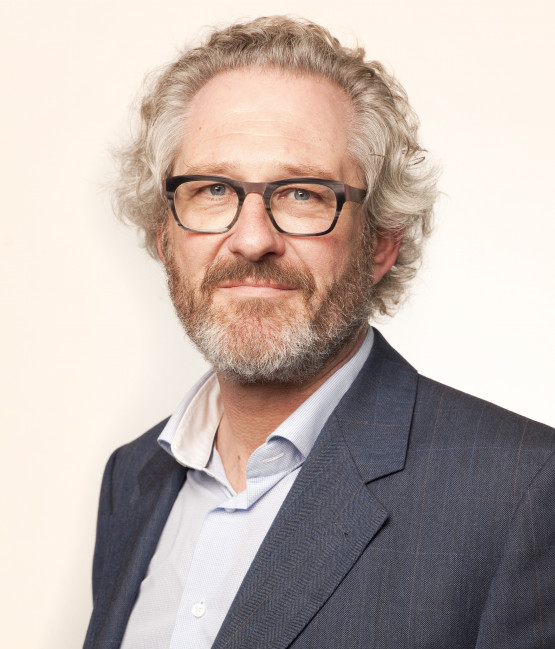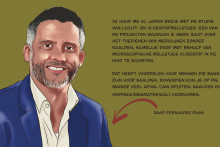You'll read about the following
In this second part in a series of investigative stories, we find out why students have hardly noticed the results from pre-investments
- Research and applied sciences universities promised to invest 600 million euros in better education, in anticipation of the release of the bursary millions.
- The money was there: before the basic grant was abolished, the academic institutions had bolstered their collective reserves with 700 million euros.
- The pre-investments were supposed to provide the first students who were no longer eligible for a study grant with better education, ‘a delusion from politicians,’ university administrators say.
- Agreements on pre-investments were kept vague on purpose.
- The annual reports from research and applied sciences universities scarcely provide any information about where the money from pre-investments came from and what it was spent on.
There is a line of students queuing in front of the university library in the city center of Groningen. The line is quickly getting longer and winds its way from the Broerstraat towards the Oude Kijk in ‘t Jatstraat. When the library was renovated in 2017, the number of study spaces was increased to 2,200. But it’s fall 2020, and students are once again standing in line due to the corona measures. At a safe distance of one and a half meters.
‘Students were quite satisfied with that renovation,’ Jasper Been says, as we stand on the steps of the Academy building in Groningen, gazing at the library across the street. ‘The building dates from the eighties and had become outdated. And it had also deteriorated quite badly. In addition, there was a shortage of study places. Students had to fight for a spot every exam period.’
No, the problem isn’t with the building’s facelift, but with the misleading information provided by the board of the University of Groningen (RUG) about the financing for the renovation, Been says. This was demonstrated by the Democratische Academie Groningen (DAG), the student movement founded by Been and a number of like-minded people back in 2017.
The university claims that it set aside an additional sum of 13 million euros to increase the number of study places in the library, to compensate students who were no longer eligible for the basic grant as of 2015. However, research carried out by Been together with his DAG colleagues Bram Omvlee and Hidde Luchtenbelt, has shown that the RUG didn’t appropriate one single euro for the first generation of loan system students.
Since 2015, students who can’t rely on a financial contribution from their parents to cover their study expenses, are forced to accumulate large debts. But they will have education of a higher quality than their predecessors who were still entitled to a basic grant were provided with. This was the promise made by minister of education Jet Bussemaker (PvdA) back in 2015 in her Strategic Agenda The value of knowledge. The hundreds of millions that the abolition of the basic student grant would generate each year was to be used in full to improve education.
The money allows research and applied sciences universities to recruit four thousand extra teachers, tutors and coaches. That will lead to more intensive and smaller scale learning: fewer lectures for large groups, more instruction lessons, more individual feedback and personal supervision. The introduction of the loan system is not a blunt spending cut, but a targeted quality impulse.
Large reserves
There is just one small problem: the bursary millions only became available in small bits as of 2018. This means that the first generation of loan system students would not benefit from the quality impulse. That is why research and applied sciences universities agreed with the minister to invest €600 million from their own reserves in education between 2015 and 2017. The money was there: in 2012, 2013 and 2014, the research and applied sciences universities had accumulated a total sum of €700 million in reserves.
600 million euros extra sounds like a lot of money, but in reality it’s only 280 euros per student annually, just a fraction of the amount loan system students miss out on. In 2015, students who still lived with their parents received a basic grant of 1.233,24 euros; students living away from home received 3.433,80 euros. But the first generation of loan system students would benefit from visible improvements in education, despite the modest sum of the pre-investments, the minister promised.
‘A delusion from politicians,’ Paul Rüpp angrily says five years later. The board president of Avans University of Applied Sciences expresses a widely held opinion among administrators at research and applied sciences universities. The promise to free up 600 million euros was necessary to convince the House of Representatives, and to secure the millions of euros from the basic grant for higher education. ‘The minister simply demanded from us that we would prefinance the promises she had made to students,’ Rüpp says.

Paul Rüpp.
The board president still vividly remembers the mood among politicians. ‘The abolition of the basic grant was a painful issue in the House of Representatives, because oh my god, those students will go out and cast their votes in the upcoming election. We need to compensate them one way or another.’ That is why the pre-investments had to ‘yield results the next day already, so that students who were no longer eligible for a basic grant would immediately see the quality of education improve,’ Rüpp continues. ‘Impossible to implement in practice, because you can’t improve education overnight.’
Minister Bussemaker’s promise that the millions from the basic grant would also allow research and applied sciences universities to recruit four thousand extra teachers, didn’t go down well with administrators at all. ‘It’s not that easy to recruit new teachers, you need a plan first, you need to know how and where you want to use them. Setting up a plan like that takes time.’
No firm commitments
The associations of research and applied sciences universities tried to control the damage by formulating the promises about pre-investments in the vaguest possible terms. What they wanted to prevent in any event, was the making of firm commitments about the recruitment of extra teachers or more contact hours to which individual institutions could be held accountable.
The Association of Universities in the Netherlands (VSNU) spoke of investing in ‘higher-quality, more intensive education and facilities that are in line with a higher education that is internationally competitive.’ The Netherlands Association of Universities of Applied Sciences (VH) promised ‘more supervision and improved monitoring, more teachers and an optimal infrastructure.’ The money should come from the reserves from the universities of applied sciences, the VH said; the VSNU believed that the universities could also free up money by making ‘rearrangements within their budgets.’
About this research
In this research, we’ve identified the pre-investments at thirteen research universities and twelve universities of applied sciences: the twelve research universities affiliated with the VSNU with the exception of the Open University, and the twelve largest applied sciences universities of 2014. We thoroughly went through the annual reports covering the years 2015 up to and including 2019 from these 25 institutions. In addition, we consulted the Quality plans, when approved and publicly available. We requested the data about the number of registered students and the number of teachers from the VSNU and the VH. The financial data comes from DUO. Since the Association of Universities of Applied Sciences doesn’t provide information about pre-investments at individual institutions, unlike the Association of Research Universities, we asked the twelve applied sciences universities to grant us access to the specification they shared with both the VH and the Netherlands Court of Audit. None of the applied sciences universities granted this information request, but three institutions were however willing to provide us with a verbal explanation.
The University of Groningen claims to have freed up a total sum of 18 million euros for pre-investments, which amounts to 207 euros per student annually. 5 million euros were intended for the development of new Master’s tracks, which had originally been budgeted at 30 million euros. Thanks to the pre-investments, the budget was raised to 35 million euros, the university board claimed.
The rest of the money supposedly went to the renovation of the university library. Not the kind of investment that immediately comes to mind when you think about the improvement of education. But the quality of the learning environment has an effect on learning results, and that is why research and applied sciences universities counted ‘modernizing the infrastructure’ among the ways to improve education.
Old wine in new bottles
Jasper Been represented DAG in the university council in the academic year 2017/2018, and therefore had access to all policy documents about pre-investments. He ploughed through all documents from the period 2014/15 and discovered that the RUG had set aside 35 million euros for the development of new Master’s tracks in March 2014 already. Months before national agreements about pre-investments were made. The renovation plan for the university library – including the 2,200 study places – was even drawn up in January 2014.
The RUG apparently presented old plans as new pre-investments, the DAG researchers concluded in their web publication Hoe de RUG haar beloftes brak en jij geen beter onderwijs kreeg (‘How the RUG broke its promises and you didn’t get better education’). The RUG failed to do anything extra for the first generation of loan system students.
With the minister’s approval
Jasper Been decided to confront the executive board with these findings during the university council meeting of March 2018. ‘And we were allowed to! We had the minister’s approval,’ executive board president Sibrand Poppema said. According to him, minister Bussemaker said during a verbal consultation with the Association of Research Universities, of which Poppema was vice-president, that previously made expenditure plans could also be regarded as pre-investments.
‘You’re also allowed to include the things that you already do to improve the quality of education. You can count buildings, you can count anything and everything,’ the minister supposedly said. ‘I remember very well that we were in the meeting and said: well, if that’s how things stand, we have no problems agreeing to those pre-investments.’
Other universities applied similar broad definitions of pre-investments. In 2015, the University of Twente listed 1.3 million euros in expenses for its new Designlab as a pre-investment, even though that laboratory had already officially been opened by minister Bussemaker in the previous year. Wageningen spent 5 million euros – at the request of students – on a sports hall that also functions as an exam hall. And VU Amsterdam claims that the 27 million euros it spent on the new building for its science departments is in fact a pre-investment, even though that building didn’t open its doors until February of last year. By that time, the first loan system students had already obtained their Bachelor’s diploma.

Even though the research and applied sciences universities weren’t exactly strapped for cash, they refused to put down in writing any promises about the level of pre-investments at individual institutions. They were once again guided by the fear of being held accountable. But minister Bussemaker was worried about the large reserves. Institutions in higher education had been hoarding their money and saw their capital grow from 1.1 to 1.7 billion euros in the period between 2009 and 2014. In university education, capital grew from 2.8 to 3.4 billion euros. Bussemaker was afraid that political support for pumping back the millions from the basic grant into higher education would dissipate if the hoarding didn’t stop. During closed meetings with administrators and supervisors, she urged them to stop setting aside money for prestigious construction projects and to spend it on education instead. Use the accumulated reserves as pre-investments, was her message.
At first sight, it appears that the thirteen research universities and twelve major universities of applied sciences we investigated listened to the minister’s appeal. Their annual reports show that the 25 institutions under investigation collectively earmarked 642 million euros for pre-investments. On average, they appropriated 343 euros per student, almost 60 euros more than promised.
The variation in pre-investments sums, however, is inexplicably large. The VU was by far the most generous institution with 1,132 euros per student, whereas students at the UvA came off worst with 109 euros. Avans leads the universities of applied sciences with 850 euros per student, and HAN University of Applied Sciences in Arnhem and Nijmegen finishes last with 85 euros per student.
These significant differences have nothing to do with the level of reserves. Amsterdam University of Applied Sciences has been at the bottom of the ranking when it comes to equity position for several decades, but it nevertheless claims to have freed up 78.7 million euros as pre-investments, which amounts to 570 euro per student annually.
Deep pockets, small investments
Even though the University of Groningen had the best equity position and the deepest pockets by the end of 2014 – the RUG had a total of 73 million euros left in the period between 2012 and 2014 – its executive board decided to earmark, as said earlier, only 18 million euros for the improvement of education for loan system students, 207 euros per student annually.
Practically none of the research and applied sciences universities – with a few exceptions – explain in their annual reports how they arrived at those pre-investment sums. The millions appear to have been chosen at random, and they also change over the years. In 2015, the University of Amsterdam, for example, claims that there is no money for pre-investments. Priority lies with keeping staff employed at the shrinking humanities department. A year later, however, the records suddenly show a pre-investment of 4.4 million euros that was supposedly spent in 2015.
The word pre-investment doesn’t even appear in the annual reports of the HAN. After extensive research, it became clear the applied sciences university used 8.6 million euros from pre-investments money to pay for Student Performance Coaching.
The Netherlands Court of Audit, which investigated whether the research and applied sciences universities delivered on their promises, reached the conclusion in 2018 that it is unlikely that the institutions invested the extra 600 million euros as promised. Only one third of the 860 million euros presented by the research and applied sciences universities to the Court of Audit as pre-investment, was spent according to the original intentions, the researchers said. A sum of 280 million euros was recognized by researchers as actual expenditure on students who started their studies without a basic grant in the period from 2015 to 2017.
Thirty percent of the presented pre-investments did not meet this requirement according the Court of Audit, and for the remaining 330 million euros it cannot be properly determined where the money came from and what it was spent on.
Research and applied sciences universities responded furiously. The Court of Audit was said to have used its own definition that didn’t correspond with the agreements made with the minister, and had therefore wrongfully rejected many pre-investments. It can’t be determined whether the Court of Audit researchers did indeed go about their work unreasonably, since the sub-reports about the individual institutions remain confidential until this very day, and because members of co-determination bodies who were allowed access to these reports are bound to confidentiality obligations.
Growing reserves
Our research shows that it is in any event unlikely that research universities drew from their reserves to make pre-investments. Collectively, they had 303 million euros to spare from 2015 until 2017. The reserves didn’t shrink, but grew.
Universities of applied sciences, on the other hand, took minister Bussemaker’s encouragements to draw from their reserves to improve the quality of education more seriously. In the fall of 2014, after they came to realize that they would once again have several tens of millions left unused by the end of the fiscal year, a number of large universities of applied sciences announced that they intend to use their hoarded millions to appoint hundreds of extra teachers.
The results prove it. The twelve universities of applied sciences we investigated seriously went into the red from 2015 until 2017. In 2016, all twelve of them closed the fiscal year with a deficit. Collectively, the ate into their reserves for a total sum of 84 million euros over a three-year period.
The fact that the universities of applied sciences drew from their reserves had already been confirmed by the Court of Audit. To find out why students scarcely noticed that financial injection, we need to take a look behind the scenes.
Take The Hague University of Applied Sciences for example. In 2016, chair of the executive board Leonard Geluk announces, in an interview with newspaper AD/Haagsche Courant, that his institution intends to invest 40 million euros in the recruitment of hundreds of new teachers over the next four years. The university of applied sciences draws from its reserves for that: a €6 million deficit is budgeted for 2016. It results in compliments from minister Bussemaker. The Hague University of Applied Sciences sets the right example, she said: invest in teachers instead of in student number growth.
Thanks to the new teachers, education becomes more small-scale, and students receive more attention, Geluk tells the AD reporters. That’s sorely needed in order to increase the dramatically low success rate. On average, only 45 percent of students at The Hague University of Applied Sciences obtains a degree after five years. That number is even lower among students from migrant backgrounds: 40 percent. Internally, the financial injection is mostly sold as a means to reduce work pressure for teachers.
One year later however, the quality & work pressure policy – as the pre-investments are referred to at The Hague University of Applied Sciences – suffers a serious blow after it becomes apparent that the 2016 deficit turns out to be 11.3 million euros instead of 6 million. That is why the executive board decides, just before the start of the summer holidays, not to extend all 350 temporary contracts for the time being. ‘As a result, recently recruited new teachers suddenly had to leave again,’ says Mathieu Heemelaar, who was chair of the University council at the time. But the financial problems weren’t caused by the pre-investments. ‘The institution was financially out of control, all departments seriously went over budget,’ Heemelaar sums up the situation in 2017.
Larger classes, fewer contact hours, more work pressure
In the end, all efforts to intensify education and to lower work pressure came to nothing, Heemelaar’s successor Arend Noordam says in 2019 in an evaluation of the quality & work pressure policy. ‘Students in co-determination bodies indicate that classes are getting larger instead of smaller, and that the number of contact hours has decreased,’ the council president writes in the report. Work pressure continued to increase in 2018, the employee satisfaction survey shows, and students noticed that. ‘Teachers sometimes don’t have enough time to give feedback, or to grade tests on time.’
That’s not so strange, Heemelaar says. ‘That sum of 40 million euros was invested, but the money was passed on to the departments without being earmarked, where it was spent on other things.’ ‘We wanted concrete plans to improve student supervision and to reduce group size, but the executive board felt that the departments knew best how to use the means,’ Noordam says. ‘That led to serious confrontations with the executive board. We rejected budgets. It resulted in years of fighting.’


Arend Noordam and Mathieu Heemelaar.
‘The department directors simply wanted a bigger budget to plug the shortfalls,’ Heemelaar says. ‘Those hundred teachers never materialized, the personnel numbers prove it. That promise wasn’t delivered on. What it basically comes down to is that the departments got a few million euros extra, which I’m sure were used sensibly. But how the money was spent exactly can no longer be determined. And the Court of Audit came to the same conclusion.’
The annual reports indeed only show the ‘extra financial means made available to the departments to lift the quality of education to a higher level and to reduce work pressure:’ 5 million euros in 2015, 10 million in 2016 and 11 million in 2017. No information is provided about how the money was spent. ‘Sad,’ Heemelaar says. ‘We urged for earmarks, because otherwise you can’t demonstrate the validity of your choices. You also need to be able to explain to students what the money from the basic grant is used for.’
When we asked for the statements that were submitted to the Association of Universities of Applied Sciences and the Court of Audit so that we could gain more insight into the matter, The Hague University of Applied Sciences replied that it was pre-agreed that the VH only reports about pre-investments on a national level, and that the institutional reports from the Court of Audit are confidential. We will have to make do with the publicly available annual reports, which do not provide students at The Hague University of Applied Sciences with any information about what happened to the money from the basic grant.
Avans University of Applied Sciences didn’t go along with the trend to draw from reserves to appoint extra teachers, even though the institution was in a healthy financial position in 2014. The Brabant applied sciences university had more than one hundred million euros to spend in the period from 2009 to 2014.
In early 2015, after it becomes clear that the institution had a new record amount of 27 million euros (11 percent of the total revenue) left over in 2014, the central representative council decided that it was enough. The council wants the board to rapidly invest more money in education. Students want more personal contact with teachers and ask for an increase in the number of contact hours. Teachers find the work pressure too high and consider the option of ‘more help during classes.’ But the executive board is not prepared to ‘simply appoint extra teachers’ because it believes that this doesn’t automatically lead to better education. First, there needs to be a well-argued plan, about which the representative body naturally has a say.
5 percent rule
At the end of 2015, the executive board and the council reached an agreement. Teachers will be allowed to spend 5 percent of their scheduled hours (80 hours a year, or two hours a week), at their own discretion, on extra contact hours with their students. That’s not without obligations though, teacher activities need to be accounted for. With the measure, which costs between 5 and 6 million euros, Avans will be able to recruit sixty to seventy percent extra teachers.
The 5 percent rule is just one of several measures taken by Avans in the context of pre-investments. The institution also raised the amount it allocates to the academies per student so that they have greater financial freedom to renew their curricula, and it invested substantially in professionalization of teachers. At the same time, Avans spent millions of euros on the renovation of a teaching facility in Den Bosch and on the development of new, two-year programs.
In total, Avans freed up 74.4 million euros for pre-investments. What the money was spent on can be easily determined. Because even though the academies at Avans have much financial freedom, they nevertheless need to be able to prove that the money was spent on goals that were agreed upon beforehand. This is checked by the accountant.
Avans responded positively to our request for clarity on the information about the pre-investments that the Association of Universities of Applied Sciences and the Court of Audit were provided with, but only wanted to give us a verbal explanation. Only in a second conversation with Rüpp does it become clear that the Court of Audit has only classified 20 percent of the 74.4 million euros that Avans declared as real pre-investment and 15 percent as possible pre-investment.
Rüpp profoundly disagrees with that. ‘We spent a substantial amount on the launch of two Associate Degree academies, where we offer two-year programs. We had already planned to do so, but we accelerated it with the money from the pre-investments. The Court of Audit didn’t accept that.’ That’s because students who started their studies in 2015 without a basic grant will not benefit from those investments, he admits. But that’s a ‘nonsensical criterion,’ Rüpp believes, ‘because there a hardly any investments in education that deliver results immediately.’
But even if you leave the eighty percent of expenses that were rejected by the Court of Audit out of consideration, Avans still spent more money than its share of the 600 million euros that the institutions of higher education agreed to invest, Rüpp concludes with satisfaction. According to his own definition, Avans spent several millions more. ‘On top of the bursary millions that are being released since 2018, we add our own money, so that the total prefinancing ends up being almost double what we promised in 2014.’
We will publish our next article, ‘How the bursary millions evaporated due to the increase in student numbers,’ on our website next Friday, February the 12th.
With the participation of Altan Erdogan, Laura ter Steege and Henk Strikkers. This is part of a series of research stories about student advance funds, made possible by the Stimulation Fund for Journalism and various editorial boards at research and applied sciences universities in the Netherlands.











